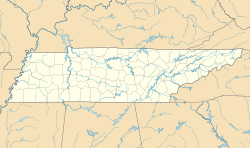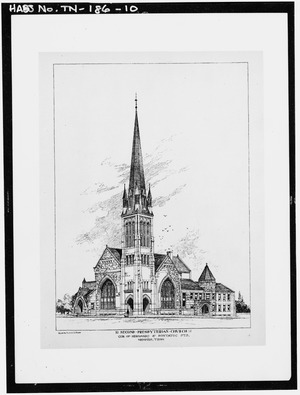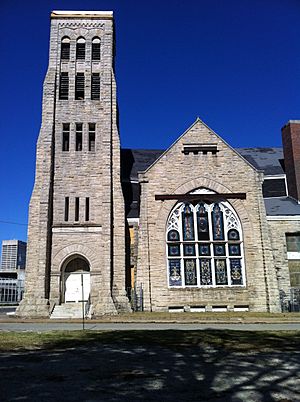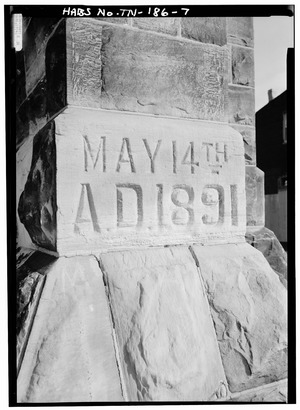Clayborn Temple facts for kids
Quick facts for kids |
|
|
Clayborn Temple
|
|
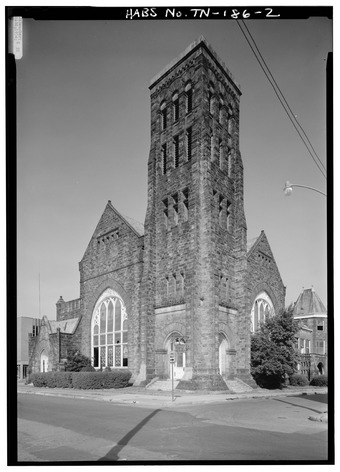
The church from the Historic American Buildings Survey
|
|
| Location | 294 Hernando St, Memphis, Tennessee |
|---|---|
| Area | 0.6 acres (0.24 ha) |
| Built | 1891 |
| Architect | Kees & Long; E.C. Jones |
| Architectural style | Romanesque |
| NRHP reference No. | 79002478 |
| Added to NRHP | September 4, 1979 |
Clayborn Temple was a very important historic building in Memphis, Tennessee. It was first known as Second Presbyterian Church. The building was added to the National Register of Historic Places in 1979 because of its special design. Later, in 2017, it became even more important for its role in the 1968 Sanitation Workers' Strike.
The church was sold in 1949 to the A.M.E. Church. They renamed it Clayborn Temple after their bishop. Sadly, on April 28, 2025, a fire destroyed the church. Investigators believe the fire was set on purpose.
Contents
A Look Back: Clayborn Temple's Story
Building the Church
In 1888, the Second Presbyterian Church decided to build a new church. They bought land at Pontotoc and Hernando streets. Construction started on February 2, 1891. The first stone was laid on May 14. The church officially opened on Sunday, January 1, 1893. All the Presbyterian pastors in Memphis joined the celebration.
In 1949, the church moved to a new location. They sold the old building to the African Methodist Episcopal Church. This church then named the building Clayborn Temple.
The Church's Design
The Clayborn Temple was built in 1891. It was designed in a style called Romanesque Revival. This means it looked like old Roman buildings. It had strong stone walls and a special roof shape. The inside had large wooden beams. It was very big for its time. When it opened, it was the largest church in America south of the Ohio River.
Clayborn Temple and the Civil Rights Movement
A Center for Change
Throughout the 1960s, Clayborn Temple became a key place for the civil rights movement in Memphis. People saw that unfair treatment based on race was connected to unfair jobs and pay. Labor unions had tried for years to fix problems in Memphis. These problems included unfair hiring, bad working conditions, and very low wages.
On February 1, 1968, two city sanitation workers, Echol Cole and Robert Walker, died in a terrible accident. This event brought many groups together. Sanitation workers, unions, religious leaders, and the Black community decided to work as one. They started a movement to demand change.
The Sanitation Strike of 1968
On February 12, 1968, 1,300 sanitation workers went on strike. They worked for the Memphis City Department of Public Works. T.O. Jones, a union organizer, and Jerry Wurf, a national union leader, led the strike.
Every day, the strikers marched 1.3 miles from Clayborn Temple to City Hall. Other groups joined them. They made sure the workers' families had food. These groups included the Mallory Knights and the Invaders. Another group was Community On the Move for Equality (C.O.M.E.). This group had 150 local ministers led by Reverend James Lawson.
Ministers at Clayborn Temple were also very involved. Reverend Ralph Jackson gave powerful speeches. Reverend Malcolm Blackburn, Clayborn's pastor, was a strong supporter. He opened the church's offices and rooms for meetings. These meetings helped plan the strike.
Dr. Martin Luther King Jr. Joins the Fight
In March 1968, Dr. Martin Luther King Jr. came to Memphis. He came to support the sanitation workers. Reverend Lawson and C.O.M.E. invited him. They wanted to bring national attention to their fight for fair pay. Dr. King and his group, the Southern Christian Leadership Conference (SCLC), helped plan a big march.
On Thursday, March 28, many people gathered at Clayborn Temple. They were waiting for Dr. King. About 15,000 people joined the march. Students even left school to be part of it. Dr. King arrived around 11:05 AM. He and the sanitation workers led the march.
After marching only a short distance, some young people became upset. There was a rumor that police had hurt a student. This led to some people causing trouble. The police reacted strongly. They used force against both peaceful marchers and the young people. Reverend Lawson and Reverend Jackson told everyone to go back to Clayborn Temple.
The marchers went back to the church. Police surrounded the building. Inside, the church looked like a war zone. Many people were hurt and scared. Police attacked those who tried to leave with spray, gas, and clubs. At one point, police even entered the church.
That day, 4,000 National Guard troops came into the city. Two hundred eighty people were arrested. Sixty people were hurt. A sixteen-year-old boy named Larry Payne died. He was shot by a police officer. Larry Payne's funeral was held at Clayborn Temple on April 2, 1968.
Dr. King was taken back to his hotel when the march became chaotic. He promised to return to Memphis for a peaceful march. He came back a week later. But he was killed on April 4, 1968, before his second march could happen. On April 16, a deal was made. The sanitation workers got their union recognized and better pay. The strike officially ended.
After Dr. King's Death
After Dr. King's death, Clayborn Temple remained a safe place. It was a meeting spot for the Civil Rights Movement in Memphis. The church was used a lot during the 1969 Black Monday protests. These protests were led by Ezekiel Bell and the NAACP. Black Mondays aimed to get African Americans on the school board. They also wanted to further desegregate public schools.
In November 1969, large meetings were held at Clayborn Temple. Thousands of protesters marched from the church. Reverend Ralph Abernathy, who took over from Dr. King, led these marches. Clayborn Temple was central to the Black Monday protests. A compromise was reached in late November. Two African Americans were appointed to the school board.
Disrepair and Restoration Efforts
Over time, Clayborn Temple's church group became smaller. It was hard to keep up the large building. Eventually, the group moved out. The A.M.E. Church left the building empty for more than ten years.
In October 2015, a group of people from Memphis started to fix up the church. They planned to add a museum and a courtyard. Money for the repairs came from groups like the African American Cultural Heritage Fund. The work was expected to cost about $18 million. It was planned to be finished in 2026.
The Fire of 2025
Sadly, while the repairs were still happening, a fire started. It happened on the morning of April 28, 2025. The fire destroyed the 130-year-old building. The inside of the church was completely ruined.
On May 14, the Memphis Fire Department made the burned building safe. Then, they started investigating the fire. On May 21, 2025, the department confirmed that someone had intentionally set the fire. They asked the community for help finding a suspect. The damage to the building was estimated at $3 million. The items inside were worth about $2.5 million.


